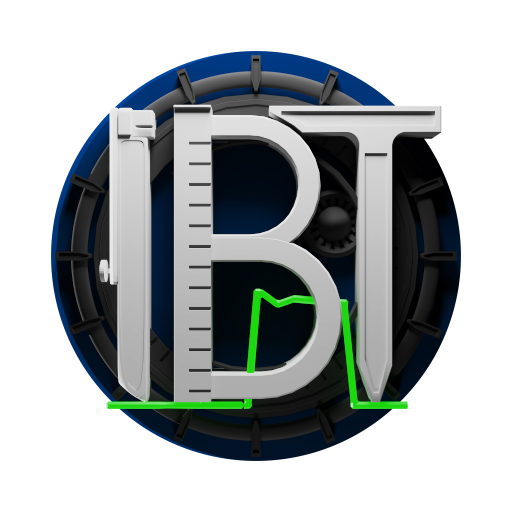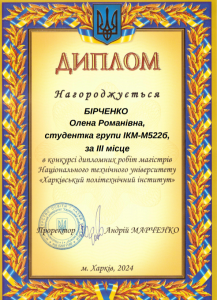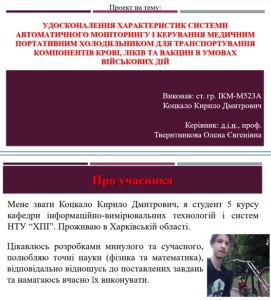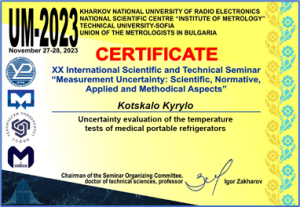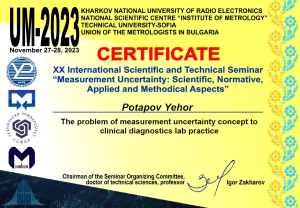According to provisions on student scientific circles student scientific associations function at the department.
Group leader: DROZDOVA Tetyana Vasylivna, associate professor of the department of IVTS
E-mail: Tetiana.Drozdova@khpi.edu.ua
Special events within the circle’s activities: participation in the Chernivtsi CIG R&D Lab startup competition. Special achievements of the participants within the circle (names of events, contests, prize places, names of prize winners): in the 2nd round of startups of the Chernivtsi CIG R&D Lab, master of computer engineering-m523a Kyrylo Kotskalo took 5th place with the topic “Improving the characteristics of the system of automatic monitoring and control of a medical portable refrigerator for the transportation of blood components, medicines and vaccines in the conditions of military operations”. The works of the student IKM-M522b O.R. Birchenko were submitted to the thesis competition of NTU “KhPI”. and female students of IKM-M522a Oliynyk M.M.
The activity of the circle regarding the involvement of its members in the startup movement: 2 works were submitted to the Chernivtsi CIG R&D Lab startup competition (K.S. Hurtovy, student of the IKM-M523a group; K. D. Kotskalo, student of the IKM-M523a group).
Publication activity (number of students who have publications within the circle’s activities, theses, articles): 5 students
- Kotskalo K., Tverytnykova O., Drozdova T. Uncertainty evaluation of the temperature tests of medical portable refrigerators. XX International Scientific and Technical Seminar “Uncertainty in Measurement: Scientific, Normative, Applied and Methodical Aspects”, November 27-28, 2023, 33-34.
- Drozdova T., Potapov E. The problem of measurement uncertainty concept to clinical diagnostics lab practice. XX International Scientific and Technical Seminar “Uncertainty in Measurement: Scientific, Normative, Applied and Methodical Aspects”, November 27-28, 2023, 25.
- Oliynyk M.M., Drozdova T.V. Visualization and data processing using geoinformation measurement systems/ Information technologies: science, technology, technology, education, health: theses of reports of the XXII international scientific and practical conference MicroCAD-2024, May 22-25, 2024 / edited by Prof. E.I. Sokol – Kharkiv: NTU “KhPI”. 521
- Gorkunov B.M., Lviv S.G., Kondrashov V.S. The method of determining the magnetic parameters of elements of power equipment taking into account the heterogeneity and non-linearity of the field / Information technologies: science, technology, technology, education, health: abstracts of reports of the XXII international scientific and practical conference MicroCAD-2024, May 22-25, 2024 / under the editorship Prof. E.I. Sokol – Kharkiv: NTU “KhPI”. C. 504.
- Gurtovyi K., Tveritnikova O.E. Application of the SOLIDWORKS program for modeling the control unit of the foam concrete manufacturing process / Information technologies: science, technology, technology, education, health: theses of reports of the XXII international scientific and practical conference MicroCAD-2024, May 22-25, 2024 / edited by Prof. E.I. Sokol – Kharkiv: NTU “KhPI”. 509.
Group leader: LYSENKO Volodymyr Valeriyovych, associate professor of the department of IVTS
E-mail: Volodymyr.Lysenko@khpi.edu.ua
Special events within the circle’s activities: participation in the scientific festival Open Weekend “Automation and measurement – a trend of the modern world”, which was held by the Educational and Scientific Institute of Computer Modeling, Applied Physics and Mathematics of NTU “KhPI” on November 18, 2023.
The publication activity of the “Laboratory of Amazing Measurements” is highlighted in the virtual museum of measuring technology on the pages of the website of the IVTS Department Link.
LIST OF RESEARCH CONDUCTED
“Time machine, or check your watches…” – a story about historical facts about the exact time signals transmitted by the RV-20 radio station in Kharkiv in 1930.
“What does this device measure?” – acquaintance with the indicator device of the device for testing radio lamps.
“How to determine if an apple is sour?” – polls using a millivoltmeter from the 1940s.
“Check your battery” – polls using a vintage SIEMENS voltmeter.
“2 devices from the Czech Republic” – an introduction to the devices of the 20s-40s of the company “METRA BLANSKO”.
“Which of you is stronger?” – an example of the use of the KhMMI production office.
Present members of the circle – students of the IKM-521a group Daria Batova and Kateryna Kyzima
Group leader: Volodymyr Mykolayovych BALEV, the head of the department of IVTS
E-mail: Volodymyr.Baliev@khpi.edu.ua
Dear students!
We invite you to join the work of the student research group “Development of measuring tools in Labview”
LabVIEW (Laboratory Virtual Instrument Engineering Workbench) is a specialized graphical programming environment that is widely used in industry, education, and research laboratories as a standard tool for data collection and control of various instruments. LabVIEW is a powerful and flexible software environment used for measurements and data analysis.
Mastering Labview allows you to quickly and efficiently develop virtual tools for measuring equipment and controlling various equipment.

With the growth of Internet capabilities, the scope of LabVIEW’s application began to expand not only in geographical, but also in virtual space. An increasing number of developers are creating virtual devices that allow remote control and monitoring via the Internet. Measuring systems based on virtual devices are characterized by their multifunctionality, flexibility and low cost, both in terms of equipment and in terms of development time.
Perhaps the best way to explain why LabVIEW is so widely distributed is to summarize how it is used. In all types of human activity, there are areas where certain types of measurements cannot be dispensed with – very often these are temperature measurements, for example in ovens, refrigerators, greenhouses, process rooms and even … in a soup pot. In addition to temperature, pressure, force, spatial displacement, mechanical stress, etc. are often measured. – the list is huge! Now personal computers have penetrated almost all spheres of life. LabVIEW accelerates the implementation of the computer in measurement systems – and not only because it facilitates the measurement, it also makes it possible to analyze the measured values, display them on graphs and reports and, if desired, publish them.
Group leader: CHUNIKHINA Tatyana Vitalyivna, associate professor of the department of IVTS
E-mail: Tetiana.Chunikhina@khpi.edu.ua
A brief description of the group’s activities
Today, hundreds of physical quantities are subject to measurement, and on the basis of measurement information certain decisions are made, very often of extreme importance. It is necessary to ensure the reliability of measurement information, that is, knowledge about the accuracy of measurement of certain parameters.
Uncertainty of measurements (from the English uncertainty) is a characteristic of measurement inaccuracy, which was adopted at the international level in 1993 (GUM-Guide to the Expression of Uncertainty in Measurements). In Ukraine, measurement uncertainty assessment is not just an urgent task, but a necessary procedure. So, in accordance with the requirements of the ISO/IEC 17025:2017 standard “General requirements for the competence of testing and calibration laboratories”, accredited laboratories must have procedures for assessing the uncertainty of the measurements they perform. The activity of clinical and diagnostic laboratories in Ukraine is regulated by the DSTU standard EN ISO 15189:2015 “Medical laboratories. Requirements for quality and competence”. According to the requirements of this standard, each laboratory must evaluate the measurement uncertainty for all methods used to obtain quantitative characteristics of physical quantities in patient samples.
Therefore, measurement uncertainty assessment is an integral component for many types of production and spheres of providing certain services.
As part of the group’s work, students will be provided with basic information on the concept of measurement uncertainty, which is based on many provisions of error theory, in particular, probability theory and mathematical statistics.
Students gain practical skills in working with current regulatory and technical documentation, which establishes methods for determining quality and safety indicators of products and raw materials in the food and chemical industries, as well as methods for performing verification of measuring channels at electric power facilities.
And in the end, students will have a generalized idea about the approach to assessing the uncertainty of measurement results in any industry and production.
